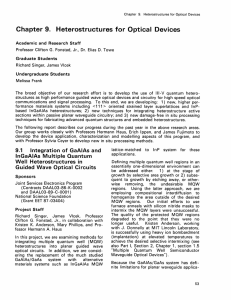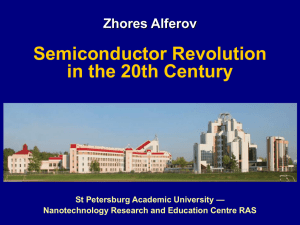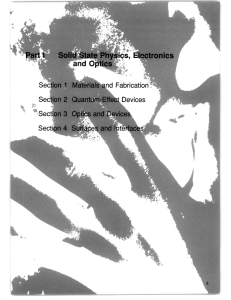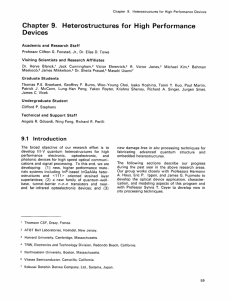Devices Chapter 9. Heterostructures for High ...
advertisement
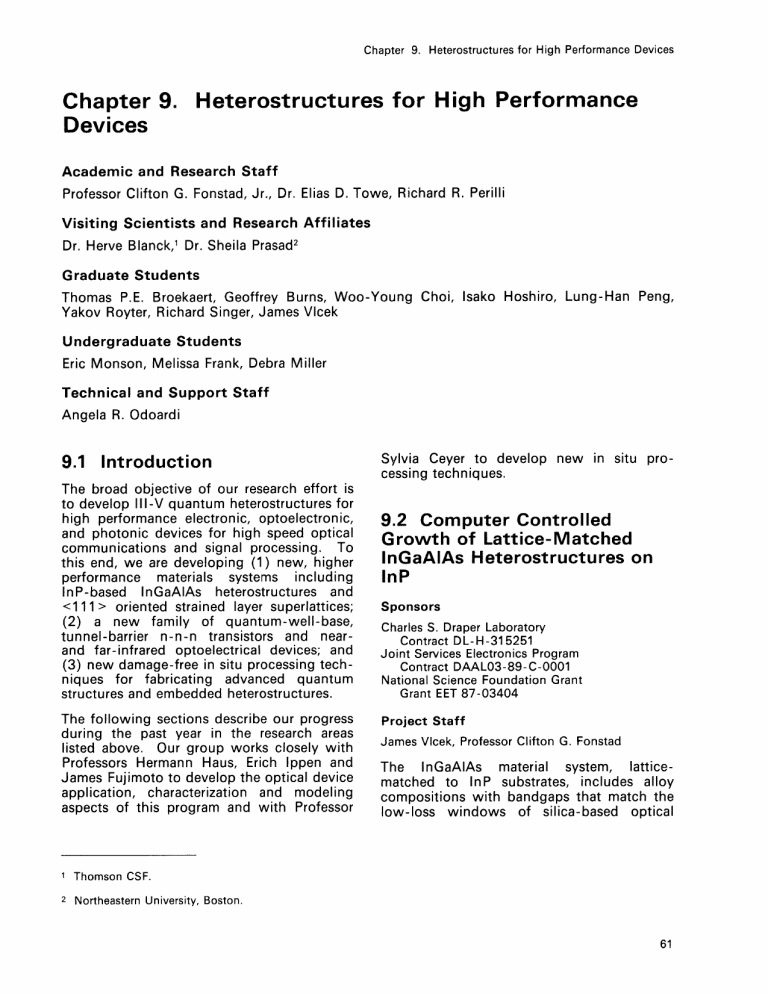
Chapter 9. Heterostructures for High Performance Devices Chapter 9. Heterostructures for High Performance Devices Academic and Research Staff Professor Clifton G. Fonstad, Jr., Dr. Elias D. Towe, Richard R. Perilli Visiting Scientists and Research Affiliates Dr. Herve Blanck,1 Dr. Sheila Prasad 2 Graduate Students Thomas P.E. Broekaert, Geoffrey Burns, Woo-Young Choi, Isako Hoshiro, Lung-Han Peng, Yakov Royter, Richard Singer, James Vlcek Undergraduate Students Eric Monson, Melissa Frank, Debra Miller Technical and Support Staff Angela R. Odoardi 9.1 Introduction The broad objective of our research effort is to develop Ill-V quantum heterostructures for high performance electronic, optoelectronic, and photonic devices for high speed optical communications and signal processing. To this end, we are developing (1) new, higher performance materials systems including InP-based InGaAIAs heterostructures and <111> oriented strained layer superlattices; (2) a new family of quantum-well-base, tunnel-barrier n-n-n transistors and nearand far-infrared optoelectrical devices; and (3) new damage-free in situ processing techniques for fabricating advanced quantum structures and embedded heterostructures. The following sections describe our progress during the past year in the research areas listed above. Our group works closely with Professors Hermann Haus, Erich Ippen and James Fujimoto to develop the optical device application, characterization and modeling aspects of this program and with Professor 1 Thomson CSF. 2 Northeastern University, Boston. Sylvia Ceyer to develop new cessing techniques. in situ pro- 9.2 Computer Controlled Growth of Lattice-Matched InGaAIAs Heterostructures on InP Sponsors Charles S. Draper Laboratory Contract DL-H-315251 Joint Services Electronics Program Contract DAAL03-89-C-0001 National Science Foundation Grant Grant EET 87-03404 Project Staff James Vlcek, Professor Clifton G. Fonstad The InGaAIAs material system, latticematched to InP substrates, includes alloy compositions with bandgaps that match the low-loss windows of silica-based optical Chapter 9. Heterostructures for High Performance Devices fibers at 1.3 and 1.55 microns. Since the constituent "elements" of the pseudo-ternary alloy InGaAIAs (InAs, GaAs, and AlAs) each have the same anion, this compound is better suited to traditional molecular beam epitaxial (MBE) growth techniques than the more commonly used InGaAsP alloy system. In electronic and optical semiconductor devices, the need for both gradedcomposition and hyper-abrupt metallurgical junctions frequently arises, but it is difficult to build these structures with solid-source Molecular Beam Epitaxy. In the case of graded junctions, the fluxes of the constituent elements must be precisely controlled during the growth process to maintain lattice matching of the epitaxial layer to the substrate, while varying the ratios of two or more beam fluxes to each other. This control is accomplished by ramping the setpoint temperature of the effusion cells for the constituent elements of the growing crystal. Achieving hyper-abrupt junctions, on the other hand, is complicated by use of mechanical shutters to block the beam fluxes during the growth process. Opening and closing of these shutters changes the thermal characteristics of the effusion cell, leading to transients in the emitted flux which must be removed to achieve truly abrupt metallurgical junctions. Complications encountered in the growth of both graded layers and hyper-abrupt junctions can be addressed by a common solution: construction of a model for the effusion cell which takes into account not only the nonlinear relationship between flux and temperature, but also the temporal response of the cell to setpoint changes. This model is then used to construct the proper setpoint temperature profiles to achieve either a time-varying flux profile for a graded layer, or a flat flux profile to remove a shutter transient. These temperature profiles are executed by a digital computer which communicates with the feedback-loop (or PID, for Proportional Integral Derivative controllers which stabilize the effusion cells). With this scheme, we have grown compositionally graded layers with maximum deviation from the desired flux profile maintained below one percent, reducing flux transients from values in the range of 10 to 25 percent 62 RLE Progress Report Number 132 to less than 1.5 percent. Current research on this topic includes extending models of the effusion cell and eliminating overlapping shutter transients similar to those that would occur in superlattice structures (multiple, closely-spaced abrupt heterojunctions). 9.3 InGaAIAs Multiple Quantum Well Heterostructures for Guided Wave Optics Sponsors National Science Foundation Grant Grant EET 87-03404 Project Staff James Vlcek, Professor Clifton G. Fonstad, Jr., in collaboration with Mary R. Phillips and Professor Hermann A. Haus Through the use of quantum confinement at InGaAs/InAIAs heterojunctions, emission and absorption edges of epitaxial grown structures can be continuously varied over the wavelength range of 1.3 to 1.6 microns, making them compatible with silica fiber communications. In addition to use in semiconductor lasers for optical emission and photodetectors for signal detection, these heterostructures can be employed for alloptical devices such as waveguides and modulators. The dynamics of optical nonlinearities in the transparent region of these structures will be an important factor in the speed of refractive, all-optical switches. To measure subpicosecond optical nonlinearites just below the superlattice bandgap, we have fabricated InGaAs/InAIAs multiple quantum well heterostructures. In a pump-probe experiment, we collaborated with Mary R. Phillips and Professor Hermann A. Haus of RLE to measure the refractive and absorptive nonlinearities of these samples. A typical heterostructure consisted of 72 periods of an InGaAs/InAIAs superlattice, each with periods of 70 A. This structure was grown using the computer-automated MBE system described in Section 9.2. Room temperature infrared absorption measurements of our best sample showed clear, strong excitonic absorption lines for both n=1 and n=2 transitions. Both the n=1 light and Chapter 9. Heterostructures for High Performance Devices heavy hole transitions were within 1 meV of the projected value, while the n=2 heavy hole transition was within 11 meV of the Single crystal x-ray projected value. diffraction measurements clearly showed the first-order superlattice satellite peaks, and photoluminescence measurements at 23.1 K showed a strong peak at 1.357 micron with a linewidth of 5.0 meV, demonstrating the excellent period-to-period control of the superlattice barrier and well widths. We made degenerate pump-probe measurements of optical nonlinearities 25 meV below the band edge of the superlattice with 150 fsec pulses at a power density on the sample of 100 MW/cm 2 from an additive-pulse- modelocked color center laser. The noncollinear pump and probe beams propagated normally to the quantum well layers. We measured the synchronous differential transmission and reflection of the probe as a function of delay between the two pulses. We discovered three time constants characteristic of the superlattice from these measurements. An extremely short time constant, faster than the resolution of the pulse, is due to a blue shift of the exciton line caused by the optical Stark effect. A 250 fsec and a long time constant (on the order of tens of nanoseconds) are probably caused by bleaching of the exciton line by the presence of photo-generated excitons and free carriers. of measurements simultaneous These reflection and transmission dynamics proved a means of quantifying index of refraction changes relative to those in absorption without making an interferometric phase measurement. Further measurements made at different temperatures will help us to determine the relative contribution of the fast and slow components as functions of detuning from the band-edge. This information will help us optimize the performance of nonlinear optical devices which are based on MQW materials. 9.4 MBE-Grown InGaAIAs/InP Long-Wavelength Laser Diodes for Narrow Linewidth Applications Sponsors Charles S. Draper Laboratory Contract DL-H-315251 Project Staff Woo-Young Choi, James Vlcek, Yakov Royter, Isako Hoshiro, Professor Clifton G. Fonstad, Jr. Semiconductor lasers emitting at wavelengths of 1.3 to 1.5 um are a key element of communication fiber optical low-loss systems. A quaternary alloy InGaAsP latticematched to InP substrates is the material system most often used for these laser diodes. Liquid phase epitaxy (LPE) and epitaxy vapor chemical metal-organic (MOCVD) are the usual growth techniques for this material system. The InGaAIAs material system, grown by conventional solid-source molecular beam epitaxy (MBE) techniques, is another promising candidate for laser diodes emitting in the 1.3 to 1.5 ym range. The InGaAs/InAIAs heterojunction has a larger conduction band discontinuity than the InGaAs/InP heterojunction. This enhances the quantum confinement of electrons, giving the device designer greater latitude in choosing layer structures for optimal electrical and optical confinement profiles. This enhanced design latitude, in turn, can be used to achieve lower threshold currents and temperature variation (To), and narrower spectral linewidth. Our goal is to fabricate InGaAs/InAIAs quantum well laser diodes which achieve the improveperformance above-mentioned ments. Initially, we focused our efforts on development of basic laser diode technology. We grew MBE double heterostructure laser materials; fabricated broad-area and stripe laser diodes; and characterized their threshold currents, emission spectrum, far-field pattern, and temperature dependence of threshold currents. Initial data indicate that our devices are comparable to other laser diodes of the same material system reported Chapter 9. Heterostructures for High Performance Devices in the literature. Now, we are in the process of optimizing our layer structure, growth conditions, and device fabrication technology which should greatly enhance device performance. In addition to multiple quantum well laser diodes, we are investigating the use of graded-index optical confinement structures for (1) an optimal gain profile with minimal angular dispersion of the emitted beam and (2) structures utilizing controlled amounts of lattice mismatch strain in the active layer to further enhance the quantum size effects of the confined carriers. To achieve our long range goal of producing ultra-narrow linewidth devices, we are extensively analyzing various theoretical techniques for reducing laser linewidth. Our ultimate goal is to produce room temperature laser diodes with emission linewidths below 100 kHz. 9.5 InGaAIAs Strained-Layer Heterostructures on 111 GaAs and InP for Optical for Modulator Applications Sponsors Joint Services Electronics Program Contract DAAL03-89-C-0001 National Science Foundation Grant Grant EET 87-03404 Project Staff Richard Singer, Professor Clifton G. Fonstad, Jr., in collaboration with Stuart D. Brorson, Daryl Smith, 3 B. Laurich, 3 Christian Mailhoit, 4 Bruce D. 5 McCombe, 5 and Bernie A. Weinstein When epitaxial layers with a slight lattice mismatch are deposited upon (111)-oriented GaAs or InP substrates, piezoelectric fields Whether a field points are generated. <111>A or <111 >B is a function of whether a given epilayer is under tensile or compressive strain. Our group was the first 3 Los Alamos National Laboratory. 4 Lawrence Livermore National Laboratory. 5 State University of New York at Buffalo. 64 RLE Progress Report Number 132 to produce these structures and to demonstrate experimentally the existence of piezoelectric fields. We are now applying this effect to optoelectronic devices. If a quantum well structure is grown through appropriate choice of ternary composition and layering, the strain-induced field will red-shift the excitonic resonance of the well. This is the familiar Quantum Confined Stark Effect (QCSE). In the present structures, the internal strain-induced field provides a bias An applied on the order of 105 V/cm. voltage will either enhance or counteract the strain-induced field around a bias point in a highly sloped, nearly linear region of the field verses index and/or absorption characteristics of these structures. Thus, the external bias is expected to dramatically affect the transmittance or reflectance of the multiple quantum well structure at a given wavelength. Practical, low voltage modulation of optical signals should be possible. Presently, we are seeking to grow, fabricate, and characterize window and waveguide p-i-n modulators in both the GaAs and InP material systems. Material of good surface morphology has been successfully grown by molecular beam epitaxy on (111) GaAs, and samples of (111)-oriented strained layer heterostructures have been distributed to a number of researchers interested in studying them. Recently, reflection modulators consisting of a mirror region of quarter wave plates and an active region of strained multiple quantum wells have been grown and tested with no applied bias. Work is currently underway to process these devices so that we can study their response to applied voltages. MBE growth on InP is more difficult because of the conflicting requirements of a low substrate temperature and high As overpressure to stabilize the volatile (111) surface, on the one hand, and the opposite growth conditions needed to enhance surface mobility of Al on the other. To overcome this diffi- Chapter 9. Heterostructures for High Performance Devices culty, we will attempt a variation of migration enhanced epitaxy in which we will keep both the substrate temperature and As overpressure low. 9.6 Molecular Beam Epitaxial Growth on (hl 1) Vicinal Surfaces can evaluate them with a tunable Ti:sapphire laser. We expect that the threshold current densities of the lasers on the (111)-GaAs substrates will be lower than those on the conventional (100) substrates. This expectation is based on the fact that the relative photoluminescence emission of the layers on these substrates is higher than that on the (100) substrates. Sponsor MIT Funds Project Staff Dr. Elias D. Towe, Professor Clifton G. Fonstad, Jr., in collaboration with H.Q. Le, 6 and J.V. Hryniewicz6 Traditionally, III-V compound semiconductors have been synthesized on (100) substrate surfaces. Because it is desirable to fabricate devices on chemically etchstructured (100) surfaces, an understanding of molecular beam epitaxial growth on highindex planes vicinal to the (100) surface is important. Understanding the properties of material grown on such surfaces is also necessary. The particular planes of interest are those denoted by (hl ). We have continued our work on the growth of epi-layers on (h11) vicinal surfaces of GaAs. In particular, the growth conditions and characteristics on the (111)B, (211)B and (511)B surfaces for acceptable quality layers are fairly well understood. GaAs and (Al, Ga)As layers with luminescence superior to that of layers on the (100) surface have been grown on these surfaces. Our interest in the epi-layers on the (h11) surfaces is due to the potential for improvedperformance and for their use in novel optical devices. We are currently studying some laser devices with strained-layer active regions on (111)-GaAs substrates. The devices have been fabricated, and we will test them soon. Some waveguide structures on (211) substrates have also been fabricated so that an undergraduate thesis student 6 MIT Lincoln Laboratory. 9.7 Pseudomorphic AIAs/InAs/InGaAs Resonant Tunneling Structures Sponsor Joint Services Electronics Program Contract DAAL03-89-C-0001 Project Staff Thomas P.E. Fonstad, Jr. Broekaert, Professor Clifton G. A fundamental objective in the design of resonant tunneling diodes (RTDs) for microwave oscillators and digital switching is achievement of the highest possible peak current density at the lowest possible peak voltage, while maintaining a high peak-tovalley current ratio and wide valley region. The InGaAIAs material system, lattice matched to InP, has the design flexibility to optimize the RTD for microwave performance and switching applications in terms of peak current density and peak voltage of the RTD. Thus far, by using very thin, three monolayer AlAs barriers and InGaAs wells, within bounding regions of InGaAs lattice-matched to InP, we have achieved room temperature peak current densities in excess of 1 MA/cm 2, the highest reported value for RTDs to date, at peak voltages as low as 0.55 V. The peak-to-valley current ratio of these devices is approximately 2 to 4. For the diode structure, a turn-on threshold voltage is apparent in the I-V characteristics. This threshold characteristic can be removed Chapter 9. Heterostructures for High Performance Devices by widening the well or by including a low bandgap material, i.e., InAs, in the well. Diode structures of this type have been fabricated and display linear initial I-V characteristics with no turn-on threshold and a low peak voltage. The combination of thin AlAs barriers and InAs containing wells should allow us to further optimize the RTDs. 9.8 Three-Terminal Quantum Well Base/Tunnel Barrier Devices Sponsors Joint Services Electronics Program Contract DAAL03-89-C-0001 Project Staff Thomas P.E. Broekaert, Lung-Han Peng, Professor Clifton G. Fonstad, Jr. We have gained our objective of making direct electrical contact to a populated conduction band quantum well in a resonant tunneling configuration. Recently, in a significant breakthrough, we succeeded in etching away the layers above the InAs quantum well layer in an AIAs/InAs/InGaAs resonant tunneling diode and making electrical contact directly to this 2 to 5 nm thick layer. This major advance in this technique opens the door to development of a new class of ultra-high performance electronic, optoelectronic, and photonic devices. We beginning an aggressive are currently utilizing this advance to research program of investigate quantum-well base, tunnel-barrier n-n-n transistors; tunnel injection, quantumwell-level laser diodes for the 2 to 5 micron region; sub-picosecond quantum-well-level, tunnel-barrier infrared photodiodes; and ultrafast quantum-well-level, tunnel-barrier optoelectronic modulators and non-linear optical components. The basis for all these devices is the AIAs/lnAs/InGaAs double barrier resonant tunneling structure discussed in the previous section. There are at least three unique features of this structure which make it ideally suited for these structures. First, the AlAs 66 RLE Progress Report Number 132 tunnel barriers are unusually high relative to the InGaAs injectors and the InAs well, which yields multiple confined well states and sharp quantum structure at room temperature. Second, the InAs well lies below the band edges of the InGaAs injectors so that when it is suitably wide and doped, the first well level will be populated. This provides all-important lateral conduction in the plane of the well and the necessary ground-state optical and for detector population modulator applications. Third, the very wide range of materials in these structures has allowed us to develop a selective etch which, in turn, makes it possible to make electrical contact to the very thin quantum well layer. 9.9 Design and Fabrication of GaAIAs Heterostructure Laser Diodes for Monolithic Integration with Si Circuits Sponsors International Business Machines Corporation National Science Foundation Grant ECS 84-13178 Project Staff Geoffrey Burns, Dr. Herve Blanck, Professor Clifton G. Fonstad, Jr., in collaboration with Professor Carl V. Thompson Prospects for monolithic integration of III-V electrical and optical devices with Si circuits have focused vigorous research efforts in direct heteroepitaxial growth of these compounds on Si substrates. Developing III-V optical sources useful for VLSI optical interconnects is one goal which has been pursued by several groups. Along these lines, we have focused upon the laser diode due to its capacity for high speed modulation and large power output. During previous years, we have developed processes for direct epitaxial growth of GaAs on Si using molecular beam epitaxy. With particular attention to details of Si surface preparation, GaAs growth initiation, and in situ annealing, we have been able to repeatably produce GaAs layers with smooth growth fronts and This growth reduced defect density. sequence has been extended to produce AIGaAs\GaAs heterostructures for laser fabri- Chapter 9. Heterostructures for High Performance Devices cation, and working devices are now routinely fabricated and characterized. Unfortunately, active optical devices such as the laser exhibit degraded luminescent efficiency and reliability when fabricated in heteroepitaxial GaAs on Si; threshold currents and lifetimes presently obtained are insufficient for Si integration. These shortcomings are imposed primarily by limitations in the quality of heteroepitaxial GaAs on Si currently produced, including dislocation densities above 106 per square cm and residual strains above 109 dynes per square cm, resulting from the 4.2 percent lattice mismatch and - 40 percent thermal expansion mismatch between GaAs and Si. We have been exploring MBE growth and laser design alternatives to address these problems. Recently, we discovered that lasers can be grown selectively on window openings on Si substrates with minimal kerf regions. In addition to providing a convenient method for monolithic integration, growth patterning can reduce thermal stress on laser devices. Another advantage is its tendency for reduced growth rates near the stripe edges, providing optical and current confinement without using complicated techniques such as buried heterostructures. Devices prepared in this way have realized laser threshold currents as low as 75 mA, a two-fold improvement over lasers fabricated using etched ridge waveguide techniques. Further design optimizations, including narrower stripe widths, offer opportunity for continuing improvement. We are also evaluating heteroepitaxial GaAs chemically removed from the Si substrate to study the effects of residual thermal strain on laser performance. Using photoluminescence to measure donor-valence band transition energies, which can be correlated with strain, we have observed partial relaxation of thermal strain upon removal of the epitaxial GaAs. Using methods which we have developed to handle and process thin (~4 micron) layers, rapid thermal annealing will be employed in an attempt to remove the remaining strain. Following these initial experiments, laser epitaxial layers will also be lifted off, processed, and characterized to provide the first data to evaluate separately the effect of strain on laser performance. 9.10 Microbridge Suspension of Monolithic GaAIAs Heterostructures Grown on Si by MBE Sponsors International Business Machines Corporation National Science Foundation Grant ECS 84-13178 Project Staff Geoffrey Burns, Dr. Herve Blanck, Professor Clifton G. Fonstad, Jr. As discussed in the preceding section, the tensile stress caused by the thermal expansion coefficient difference between GaAs and Si is a crucial problem facing GaAs-on-Si devices. We have made preliminary studies of a unique technique to overcome this problem. In this technique, we physically separate the GaAs device layers from the Si, except for preformed metal microbridges that hold it in place on the substrate. Recent work by Yablonovitch et al. of Bellcore, who used an AlAs sacrificial layer to remove GaAIAs heterostructures from GaAs substrates for hybriding, provided the basis for this technique. Using mesa, drain and source pad masks from an existing MESFET mask set, with GaAs-on-Si layers grown with 50-nm thick AlAs "sacrificial" layers, we have demonstrated the possibility of using the Yablonovitch technique to physically separate AIGaAs device regions from the initial, high defect density nucleation layers and the Si substrate, leaving them in position on the Si wafer held by thin gold leads. Photoluminescence measurements on GaAs pieces etched free of their Si substrates show a peak shift in the direction of reduced strain, but do show full relaxation of the stress. We are currently studying the effects of postseparation annealing (see preceding section). In addition to laser diodes, we are applying the microbridge suspension concept to a number of devices. The etalon formed by removing the AlAs sub-layer should be ideal for forming optical modulator cavities and Chapter 9. Heterostructures for High Performance Devices surface emitting laser cavities. Furthermore, the dielectric isolation provided by the thin air layer will greatly diminish the substrate parasitics experienced by high speed GaAs the in fabricated circuitry electronic GaAs-on-Si epilayers. 9.11 Damage-Free In-Situ UHV Etching and Cleaning of III-V Heterostructures Using Molecular Beams Project Staff Professor Clifton G. Fonstad, Jr., in collaboration with Professor Sylvia T. Ceyer and Professor Herbert H. Sawin The development of damage-free ultra-high vacuum etching, cleaning, and regrowth techniques compatible with molecular beam epitaxy and ex situ processing of Ill-V heterostructures is a major challenge facing device researchers. The ability to selectively pattern, etch, and overgrow quantum heterostructures is crucial to the effective realization of integrated optical circuitry and quantum effect Present techniques electronic structures. (100 eV and energy high relatively involve substantial cause which beams ion above) sub-surface damage, much of which is impossible to remove. As a solution to the problem of processinduced damage, we have begun investigating the use of UHV kinetic molecular beam techniques (widely used to study atomic interactions on surfaces) to etch and clean Ill-V substrates and heterostructures so that there is a minimum of surface damage and a maximum of flexibility. Depending on the etchant gas mixture established, we anticipate that low energy (0.5 to 2 eV) kinetic beams can be used to (1) anisotropIll-V heterostructure ically etch-pattern wafers with no damage; (2) clean surfaces allowing epitaxial growth on wafers which have been removed from the UHV environment for external processing; and (3) selectively remove masking materials and clean surfaces suitably for subsequent overgrowth. This program is based on the work of Professor Sylvia Ceyer, an expert on using supersonic beams to probe surface reactions 68 RLE Progress Report Number 132 and to etch silicon, and that of Professor Herbert Sawin, an expert on the design of molecular beam and rf plasma sources and reactors, as well as plasma reaction dynamics. We have obtained funding to assemble a UHV chamber for kinetic beam processing, which will be connected through a specially-designed transfer mechanism to the present Riber 2300 solid source molecular beam epitaxy system. Presently, we are seeking additional funding for a major collaborative research effort in this area. 9.12 Publications Bagwell, P.F., T.P.E. Broekaert, T.P. Orlando, and C.G. Fonstad. "Resonant Tunneling Diodes and Transistors with a One, Two, and Three Dimensional Electron Emitter." J. Appl. Phys. Forthcoming. Beery, J.G., B.K. Laurich, K. Elcess, C.G. Fonstad, C.G. Maggiore, C. Mailhoit, and D.L. Smith. "Growth and Characterization of (111) Oriented GalnAs/GaAs StrainedLayer Superlattices." Appl. Phys. Lett. 54: 233-235 (1989). Fonstad. and C.G. Broekaert, T.P.E., "Extremely High Current Density, Low Peak Voltage Pseudomorphic InGaAs/AIAs/InAs Resonant Tunelling Diodes." In Technical Digest of the 1989 International Electron Devices Meeting. Piscataway, New Jersey: IEEE, 1989, pp. 559-562. Broekaert, T.P.E., W. Lee, and C.G. Fonstad. "InGaAs/AIAs/InAs Resonant Tunneling Diodes with Peak-to-valley Current Ratios of 30 at Room Temperature." Submitted to Appl. Phys. Lett. Broekaert, T.P.E. The Growth and Characterization of Resonant Tunneling Diodes. S.M. thesis. Dept. of Electr. Eng. and Comput. Sci., MIT, 1989. Burns, G. Growth of (Ga,AI)As on Silicon Substrates by Molecular Beam Epitaxy. S.M. thesis. Dept. of Electr. Eng. and Comput. Sci., MIT, 1989. Burns, G.F., H. Blanck, and C.G. Fonstad. "Low-threshold GaAs/AIGaAs Graded- Chapter 9. Heterostructures for High Performance Devices index Separate-confinement Heterostructure Lasers Grown by Molecular Beam Epitaxy on Oxide-masked Si Substrates." Submitted to Appl. Phys. Lett. Chong, T.C., and C.G. Fonstad. "Theoretical Gain of Strain Layer Semiconductor Lasers." IEEE J. Quantum Electron. 25: 171-178 (1989). Frank, M. Characterization of the Pulsed Behavior of InGaAlAs Laser Diodes. S.B. thesis. Dept. of Electr. Eng. and Comput. Sci., MIT, 1989. Kim, H.M., C.R. Wie, and C.G. Fonstad. "Strain and Lattice-Mismatch in (001) and (111) GalnAs/GaAs Strained Layer Superlattices." Paper presented at the Materials Research Society Meeting, November Massachusetts, Boston, 27-December 2, 1989. Laurich, B. K., K. Elcess, C.G. Fonstad, C. Mailhoit, and D. Smith. "Optical ProperOriented ties of (100) and (111) GalnAs/GaAs Strained Layer Superlattices." Phys. Rev. Lett. 62: 649-652 (1989). Liu, X., A. Petrou, K. Elcess, C. Fonstad, and "Observation of ParityC. Mailhoit. in Transitions Interband breaking [111]-grown InGaAs/AIGaAs StrainedLayer Superlattices." Paper presented at the Meeting of the American Physical Society, San Diego, March 1989. McCann, P.J. and C.G. Fonstad. "Observation of an Interfacial Reaction Between Selenium Vapor and the Barium Flouride Surface: Implications for Heteroepitaxy of PbSe on BaF 2." Paper presented at the Electronic Materials Conference, Cambridge, Massachusetts, June 21 -23, 1989. Miller, D. Microbridge Suspension of Heteroepitaxial Gallium Arsenide on Silicon. S.B. thesis. Dept. of Mater. Sci. and Eng., MIT, 1989. Palmer, J.E., G. Burns, C.G. Fonstad, and C.V. Thompson. "Effect of As 4 Overpressure on Initial Stages of MBE Growth of Ga on Si." Paper presented at the Elec- tronic Materials Conference, Cambridge, Massachusetts, June 21 -23, 1989. Sato, H., J.C. Vlcek, C.G. Fonstad, B. "InGaAs/Meskoob, and S. Prasad. InAIAs/InP Collector-Up Microwave HetTransistors." Bipolar erojunction Submitted to Electron Device Lett. Sato, H., J.C. Vlcek, C.G. Fonstad, B. Meskoob, and S. Prasad, "High Current Density Emitter-Down InGaAIAs Heterojunction Bipolar Transitors." Paper preResearch Device the at sented Massachusetts, Conference, Cambridge, June 18-21, 1989. Towe, E., C.G. Fonstad, H.Q. Le, and J.V. Hryniewicz. "Luminescence of (AI,Ga)As and GaAs Grown on the Vicinal (511) B-GaAs Surface by Molecular Beam Epitaxy." J. Vac. Sci. Techno. B7: 395-398 (1989). Towe, E., and C.G. Fonstad. "Synthesis of GaAs and (AI,Ga)As on (511)-GaAs Surfaces by Molecular Beam Epitaxy." Proon Symposium the of ceedings Heteroepitaxial Approaches in Semiconductors: Lattice Mismatch and its Consequences. Eds. A.T. Macrander and T.J. Drummond, 347-357. Pennington, New Jersey: Electrochemical Society, 1989. Venkateswasan, V.D., L.J. Cui, M. Li, B.A. Weinstein, K. Elcess, C.G. Fonstad, and C. Mailhoit. "Strain Mapping in (111)and (100)-nGaAs/GaAs Superlattices." Appl. Phys. Lett. 56: 276-288 (1990). Venkateswaran, V.D., T. Burnett, L.J. Cui, M. Li, B.A. Weinstein, H.M. Kim, C.R. Wie, K. Elcess, C.G. Fonstad, and C. Mailhoit. "Comparison and Spatial Profiling of Strain in [001] and [111] Oriented InGaAs/GaAs Superlattices from Raman and X-ray Experiments." Submitted to Phys. Rev. B. Venkateswaran, V., L. Cui, M. Li, B.A. Weinstein, H.M. Kim, C.R. Wie, C. Mailhoit, K. Elcess, and C.G. Fonstad. in Strain of Internal "Mapping InGaAs-GaAs Superlattices." Paper pre- Chapter 9. Heterostructures for High Performance Devices sented at the Meeting of the American Physical Society, San Diego, March 1989. Yoo, B.S., J.-P. Cheng, A.A. Reeder, R. Ranganathan, Y.J. Wang, B.D. McCombe, K. Elcess, C.G. Fonstad, B. Lin, and F. 70 RLE Progress Report Number 132 Kuchar. "Far Infrared Studies of [1111] InGaAs/AIGaAs Strained-Layer Superlattices." Paper presented at the Meeting of the American Physical Society, San Diego, March 1989.
